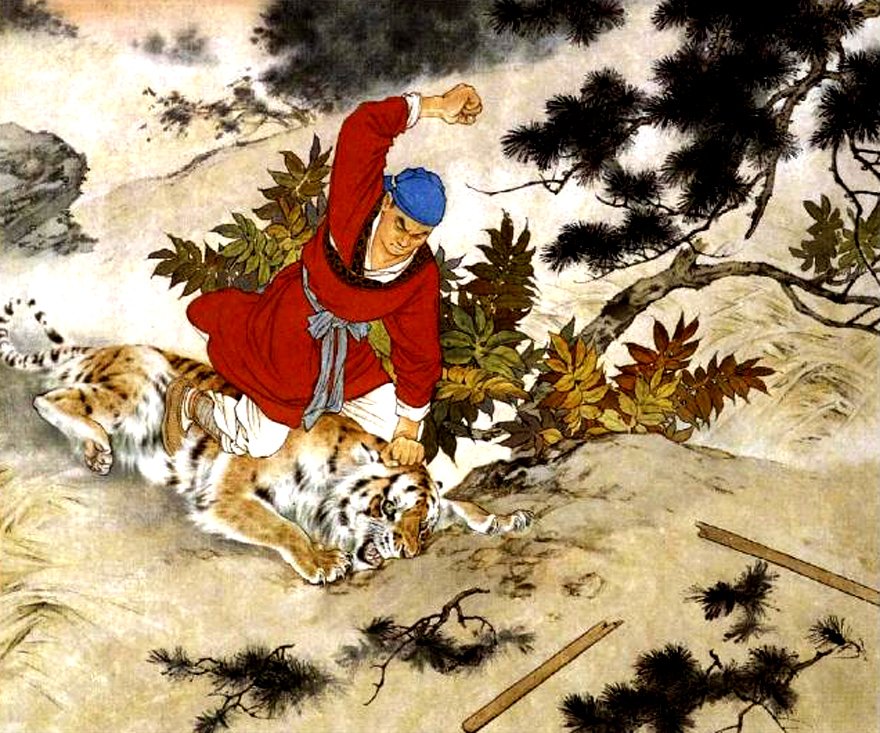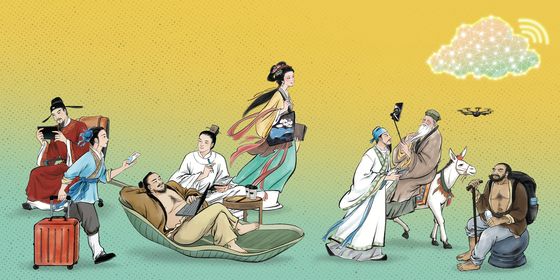Traditional folk stories about tigers still told today
As the Year of the Tiger is upon us, tiger imagery is everywhere, from rhyming couplets (春联) to handbags, postage stamps, and car adverts. Tigers appear frequently in Chinese literature and folk stories, with many idioms (chengyu) invoking the animal: Active , good-natured children are “虎头虎脑 (tiger head and tiger brain)”; tough, stocky men are “虎背熊腰 (tiger’s back and a bear’s waist)”; and people full of vigor are “生龙活虎 (lively dragon and animated tiger).”
In folk stories of old, often where these four-character idioms arise, the tiger is not always the brave and powerful animal it is made out to be today. Here are five famous folk stories involving tigers from Chinese history.
Wu Song fights the tiger 武松打虎
Perhaps the most widely known story about a tiger in China, this tale comes from the classic 14th-century novel Outlaws of the Marsh (《水浒传》), in which Wu Song is a heroic warrior.
One day, as Wu is traveling along the road to meet his brother, he stops for a drink at an inn at Mount Jingyang where he sees a sign warning of a vicious tiger in the mountains that had killed many previous travelers. Wu was unconvinced, believing the innkeeper wrote the sign to encourage travelers to spend the night in his inn at the foot of the mountain. After drinking 18(?!) bowls of alcohol, he insisted climbing the mountain alone at night to prove the innkeeper wrong.
Soon after entering the mountains, Wu passed out drunk and lay down on a rock. Just when he was about to fall asleep, he suddenly felt a strange gust of wind. Wu quickly turned around to a tiger charging toward him. He dodged the animal just in time, and a fight ensued.
After a fierce fight, Wu jumped onto the back of the tiger, grabbed its head with his left hand, and used his right fist to pummel the beast’s eyes, nose, and ears. Gradually, the tiger succumbed to Wu’s assault, and died.
In the story, Wu is lauded by the local government for slaying the tiger, and his reputation as a tiger-fighting hero spreads far and wide. Though he gets into many other adventures in the book, whenever people nowadays hear Wu Song’s name, they nearly always recall him as the hero who killed a tiger with his bare hands.
Yang Xiang wrings a tiger’s neck to save her father 扼虎救父
While Wu Song’s story is one of bravery and combat skills, the tale of Yang Xiang is meant to carry moral teachings. The tale is from the The Twenty-four Filial Exemplars (《二十四孝》), a classic text compiled by Guo Jujing (郭居敬) during the Yuan dynasty (1206 – 1368) to teach Confucian values, and tells the story of a 14-year-old girl named Yang Xiang who lived during the Jin dynasty (265 – 420).
One day, when Yang was cutting rice in the field with her father, a tiger suddenly jumped out of the undergrowth and attacked her father. Yang had no weapons on hand, but without a second thought, she grabbed the tiger by its neck with her bare hands. The tiger couldn’t escape and gradually collapsed on the ground. Yang’s father was then saved.
Though the notion of a young girl defeating a tiger in combat with her bare hands may be far-fetched, the story is meant to teach children to sacrifice themselves for their parents.
Sit and watch tigers fighting 坐山观虎斗
This tale, found in both the Strategies of the Warring States (《战国策》) and the Records of the Grand Historian (《史记》), has been used to illustrate a diplomatic strategy for centuries, and was even invoked by the King of Qin in the Warring States period (475 – 221 BCE).
During the Spring and Autumn period (770 – 476 BCE), a man named Bian Zhuangzi (卞庄子) of the State of Lu was known for his exceptional martial arts skills. On a journey in the countryside, he overheard two customers at an inn talking fearfully about two tigers in the area that are known to attack and kill people. Bian Zhuangzi decided to kill the tigers, and a waiter from the inn decided to join him in his quest.
After tracking the tigers for a long time, the two men found the beasts in a valley, feasting on a cow carcass together. Bian prepared to attack the tigers, but the waiter stopped him. “Don’t worry,” he said, “The tigers will soon fight each other over the food. Eventually one of them will die and the other will be injured. Isn’t it much easier to deal with just one injured tiger?” Bian took the waiter’s advice, and everything happened just as the waiter described.
In the Warring States period, when the State of Han and the State of Wei were at war, the King of Qin was considering whether he should intervene and broker a ceasefire. Chen Zhen (陈轸), an official in the Qin court, recounted to the king the story of Bian Zhuanzi, making the suggestion that the Qin should first wait to allow the Han and Wei to suffer great losses, then conquer them both. The king of Qin followed Chen’s advice, and took several cities from both Wei and Han once they were exhausted from fighting each other.
Three people make a tiger 三人成虎
The story of Pang Gong (庞恭), a chancellor of the State of Wei who was sent to become a hostage of the State of Zhao (a common strategy in ancient times as a type of peace-guarantee between states), comes from the Strategies of the Warring States, a text on diplomacy and strategies compiled during the Western Han dynasty (206 BCE – 25 CE). In the story, before he leaves, Pang warns the King of Wei about not believing in rumors while he is away:
“Your majesty, would you believe it if a person said he saw a tiger in the streets?” asked Pang.
“No, I wouldn’t,” answered the king.
“What if a second person said so as well?” Pang asked again.
“I would still be skeptical,” replied the king.
“What if a third person also claimed he had seen the tiger?”
“Then I would believe it’s true!”.
Pang explained the object of his questions: “As you see, even if it is extremely unlikely that a tiger would appear in the streets, so long as three people claim it is true, other people will believe them. Now, the distance from our Zhao capital Handan to Wei’s capital at Daliang is far greater than just one street, so there will be far more than three people attempting to slander my name. I hope you can discern the truth when they do.”
Pang left for Zhao, and as he had predicted, rumors about him soon began to spread, as political rivals and gossips attempted to drive a wedge between Pang and the king. When Pang finally came back to Wei, the king never summoned him to court again—Pang’s warning had not worked.
The story has become a chengyu, literally meaning “three people make a tiger,” that describes how any lie can become accepted as truth if repeated by enough people.
The fox pretending to be a tiger 狐假虎威
Tigers often feature in stories told to kings in ancient times, perhaps because of the presumed majesty of the animal. In another story from the Strategies of the Warring States, chancellor Jiang Yi (江乙) explained to King Xuan of the State of Chu why kingdoms to the north seemed to fear his general Zhao Xixu (昭奚恤), using a story about a fox and a tiger: A tiger in the forest caught a fox, but before the tiger could eat it, the fox cried, “How dare you eat me? I was made the king of all animals by the gods! If you eat me, you are challenging the gods.” To prove what he said was true, he asked the tiger to take a walk with him in the forest. The tiger agreed, and as the fox and tiger walked together through the forest, all the animals turned and fled, just as the fox had described.
Jiang’s point was that, just as the other animals in the forest were afraid of the tiger, rather than the fox, the northern kingdoms were afraid of the power of the Chu state, not Zhao Xixu as an individual.













